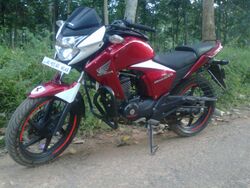Honda Unicorn
Topic: Engineering
 From HandWiki - Reading time: 3 min
From HandWiki - Reading time: 3 min
 | |
| Manufacturer | Honda Motorcycle & Scooter India |
|---|---|
| Also called |
|
| Parent company | Honda Motor Company |
| Production | 2004–present |
| Class | Standard |
| Engine | 162.7 cc (9.93 cu in) CV Fuel injection, 4-stroke, air-cooled, OHC, single |
| Bore / stroke | 57.3 mm × 57.8 mm (2.26 in × 2.28 in) |
| Top speed | 101 km/h (63 mph) (claimed)[1] |
| Power | 9.5 kW (12.7 hp) @ 7500 rpm (claimed)[1] |
| Torque | 14 N⋅m (10 lbf⋅ft) @ 5500 rpm (claimed)[1] |
| Ignition type | CDI |
| Transmission | 5-speed, manual constant mesh |
| Suspension | Front telescopic Rear monoshock |
| Brakes | Front 240 ABS mm disc Rear 130 mm drum |
| Tires | Tube type, Front 2.75 in x 18 in Rear 100/90- 18< |
| Wheelbase | 1,336 mm (52.6 in) |
| Dimensions | L: 2,092 mm (82.4 in) W: 756 mm (29.8 in) H: 1,100 mm (43 in) |
| Weight | 145 kg (320 lb) (claimed)[1] (wet) |
| Fuel capacity | 16 L (4.2 US gal) |
| Fuel consumption | 60 km/L (170 mpg‑imp; 140 mpg‑US) (claimed)[2] |
The Honda Unicorn is a motorcycle developed by Honda Motorcycle & Scooter India (HMSI) and introduced in 2004.[3] It was internally called the CBF150M. The engine was taken from the CRF150F post 2005 engine. The previous version of CRF150F was the old CBZ classic. The design of the bike was done keeping in mind Indian road conditions. Many new features were incorporated, including a two-way air jacket and a diamond frame. The first version of the bike featured spoke wheels and kick start with an optional self-starter.[4][5]
Honda claimed the Unicorn accelerated from 0 to 60 km/h (0 to 37 mph) in 5 seconds.[2] India Business Insight reported acceleration of 0 to 60 km/h (0 to 37 mph) in 5.28–5.86 seconds, and a top speed of 114 km/h (71 mph).[6][7]
Honda released this motorcycle to compete with the Bajaj Pulsar and the TVS Apache. Changes included alloy wheels, powder coated engine with a polished head, electric starter, new graphics, clear lens indicator lamps, a trip meter, and a slightly smaller rear grab rail. Few performance changes included minor changes in the cylinder head, overhead valve, ignition remap and a rear sprocket increase of one tooth, which resulted in increased acceleration at the expense of reduced top speed. The air filter was changed from a dry paper to oil-coated to better suit dusty conditions and a new airflow screw in the carburetor. HMSI sold 720,000 Unicorns in 2007.[8] The Unicorn overtook the Bajaj Pulsar to rank highest in its category, the premium segment, in the 2005 Motorcycle Total Customer Satisfaction (MTCS) survey of 7,000 customers conducted by the TNS specialist division, TNS Automotive.[9]
Honda began selling the Unicorn Dazzler variation in 2010. It has different bodywork and uses rear disc brake instead of a drum brake.[10]
References
- ↑ 1.0 1.1 1.2 1.3 Honda Motorcycle & Scooter India, Honda Unicorn specifications, https://www.honda2wheelersindia.com/unicorn-BS-VI/specifications, retrieved 13 October 2021
- ↑ 2.0 2.1 Honda Motorcycle & Scooter India (Adobe Flash), Former Honda Unicorn specifications, http://www.honda2wheelersindia.com/unicorn/specifications.html
- ↑ Honda Worldwide (September 8, 2004), Honda Motorcycle & Scooter India Announces First Motorcycle Model; Production of New "Unicorn" Model Begins on New Second Line., http://world.honda.com/news/2004/c040908b-eng.html
- ↑ Muralidhar, S. (November 28, 2004), "Honda Unicorn: Wings of change", Asia Africa Intelligence Wire
- ↑ Honda launches 'self-start' Unicorn, January 14, 2005, http://www.rediff.com/money/2005/jan/14look.htm
- ↑ India Business Insight (February 14, 2007), PROFILE OF HONDA UNICORN.
- ↑ India Business Insight (February 28, 2006), PROFILE OF HONDA UNICORN
- ↑ PTI - The Press Trust of India Ltd. (April 30, 2007), HMSI announces launch of new look Honda Unicorn
- ↑ Asia Africa Intelligence Wire (June 24, 2005), Bajaj, Hero Honda, Enfield top customer satisfaction: Study
- ↑ "Honda Dazzler launched in India". 12 May 2010. http://www.indiaon2wheels.com/honda-dazzler-launched-in-india/.
External links
 |
 KSF
KSF
